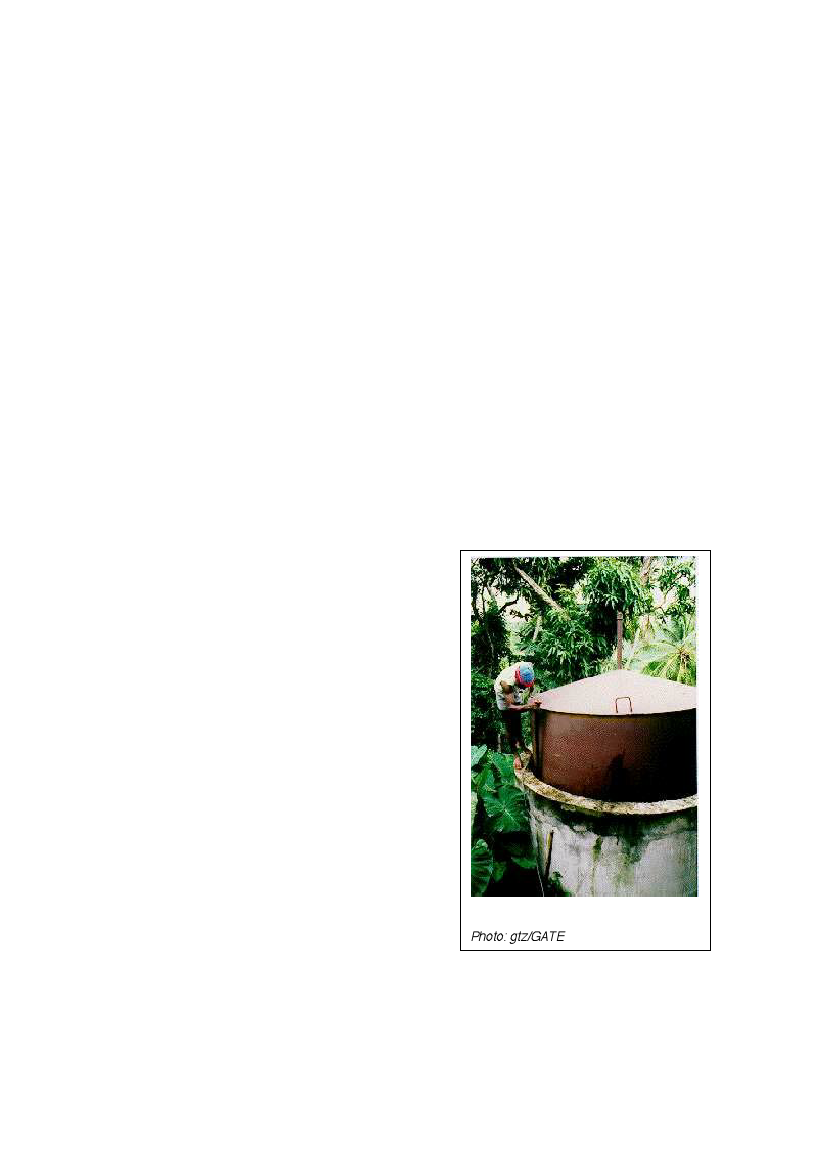
such systems are batch-fed versions into which the dung and an appropriate quantity of
water are loaded without being pre-mixed. The feed-stock is usually hauled to and from the
digester in wheelbarrows or baskets.
Chicken droppings
Chicken droppings can only be used if the chickens roost above a suitable dung collecting
area of limited size. Otherwise, the sand or sawdust fraction would be disproportionately
high. Chicken droppings can be fed into plants which are primarily filled with cow dung
without any problem. There is a latent danger of high ammoniac concentration with pure
chicken dung, but despite this there are many well functioning biogas plants combined with
egg or meat producing factories. The collected droppings are hard and dry, so that they have
to be pulverized and mixed with water before they can be loaded into the digester.
Mechanical mixing is advisable. The proportion of methane in biogas from chicken
excrement is up to 60%.
Human excrements
In most cultures, handling human excrement is loaded with taboos. Thus, if night soil is to be
used in a biogas system, the toilets in question should drain directly into the system so that
the night soil is fermented without pretreatment. The amount of water accompanying the
night soil should be minimized by ensuring that no water taps or other external sources drain
into the toilet bowls, and cleaning/flushing should be limited to rinsing out with about 0.5 - 1
liter water from a bowl. Western-style flush tanks should not be used in connection with
small-size biogas plants.
In areas subject to frequent or seasonal water shortages, sand traps are a must, since wiping
with stones is often the only means of cleaning after using the toilet.
The problem of scum
If there is heavy gas release from the inlet but
not enough gas available for use, a thick scum
layer is most likely the reason. Often the gas
pressure does not build up because of the
continuous gas release through the inlet for
weeks. There is a danger of blocking the gas
pipe by rising scum because of daily feeding
without equivalent discharge. The lid (or man-
hole) must be opened or the floating drum
removed and scum is to be taken out by hand.
Separation of material
Straw, grass, stalks and even already dried dung
tends to float to the surface. Solid and mineral
material tends to sink to the bottom and, in the
course of time, may block the outlet pipe or
reduce the active digester volume. In properly
mixed substrate with not too high water contents,
there is no such separation because of sufficient
friction within the paste-like substance.
Substrate
Figure 25: Destruction of the scum in
a floating-drum plant in the Carribean
Photo: gtz/GATE
With pure and fresh cattle dung there is usually no scum problem. Floating layers will
become a problem when e.g. undigestible husks are part of the fodder. This is often the case
in pig feeds. Before installing a biogas plant at a piggery, the kind of fodder and consequently
the kind of dung, must be checked to ensure that it is suitable for a biogas plant. It might be
necessary to grind the fodder into fine powder. The user must be aware of the additional
costs before deciding on a biogas unit. The problem is even bigger with poultry droppings.
The kind of fodder, the sand the chicken pick up, and the feathers falling to the ground make
44